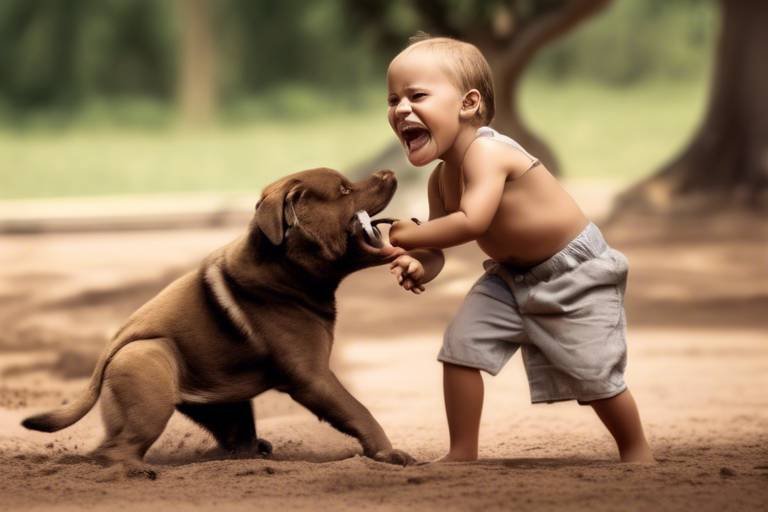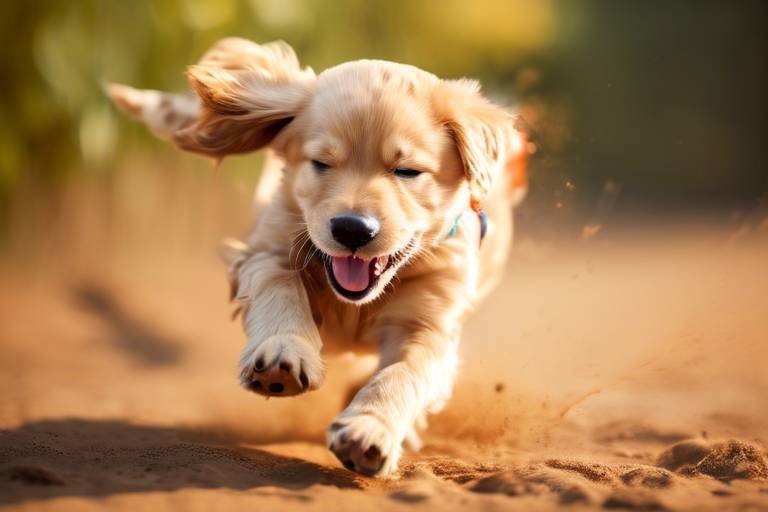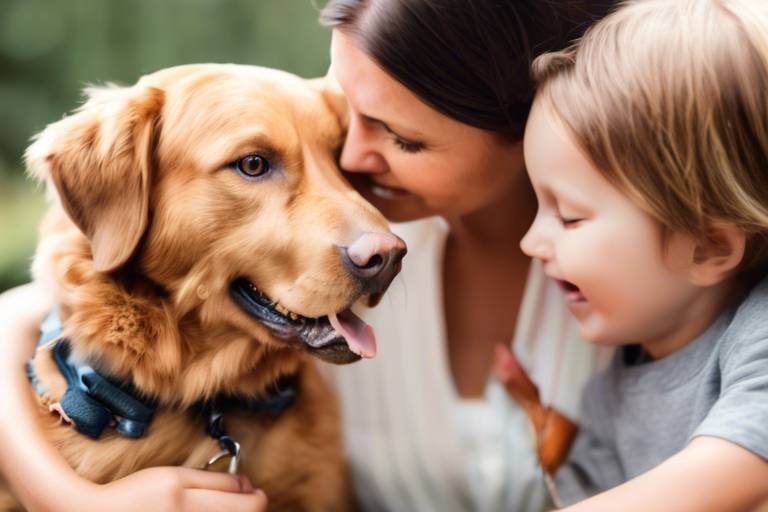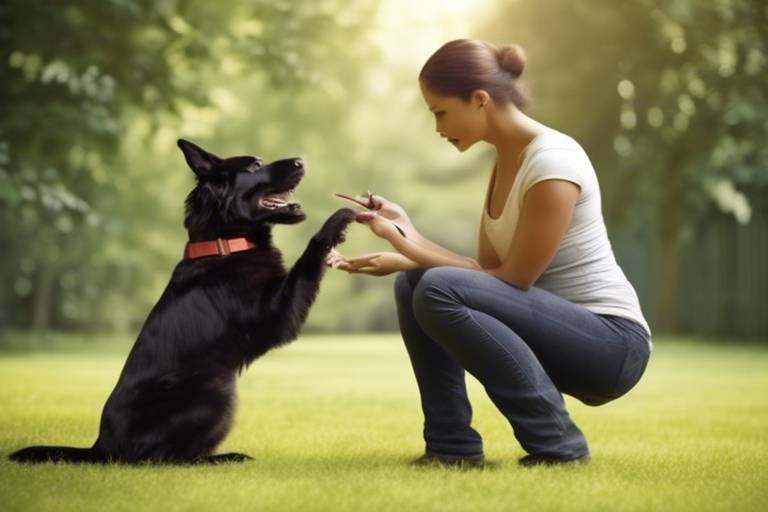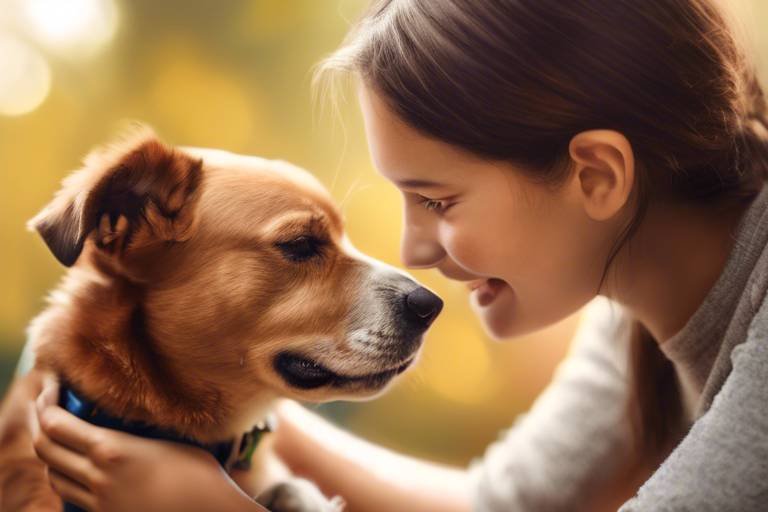Understanding the Impact of Breeds on Behavior
When it comes to choosing a dog, understanding the impact of different breeds on behavior is crucial. Each breed carries its own unique set of characteristics that can significantly influence personality traits, training approaches, and overall compatibility with potential owners. Imagine walking into a dog shelter or a breeder's facility, and you're faced with a myriad of choices. How do you know which furry friend will fit into your lifestyle? This article dives deep into the fascinating world of dog breeds, shedding light on how their inherent traits can shape their behavior and your experience as a dog owner.
The relationship between breed and behavior is not just a matter of anecdotal evidence; it's backed by science. Research has shown that genetics play a pivotal role in determining a dog's temperament and actions. For instance, a Border Collie is likely to exhibit herding instincts, while a Labrador Retriever is often known for its friendly and sociable demeanor. This genetic predisposition can help prospective dog owners make informed decisions about which breed aligns with their lifestyle and expectations. Understanding these traits is like having a map that guides you through the sometimes overwhelming journey of dog ownership.
Moreover, recognizing the behavioral tendencies associated with different breeds can empower you to create a harmonious environment for your new companion. For example, if you're an active person who enjoys outdoor activities, a high-energy breed like a Siberian Husky might be a perfect match. On the other hand, if you prefer a more laid-back lifestyle, a Bulldog or a Basset Hound could be more suitable. The key is to find a breed that complements your daily routine and energy levels, ensuring a fulfilling relationship for both you and your pet.
In this article, we will explore various dog breeds, examining their behavioral traits, training needs, and the influence of their environment. We will also discuss how effective socialization and tailored training approaches can enhance a dog's behavior, making the transition into your home smoother and more enjoyable. Whether you're a first-time dog owner or a seasoned enthusiast, understanding the impact of breeds on behavior is essential for fostering a loving and well-adjusted canine companion.
Delving into the genetic factors that shape a dog's behavior, this section examines how breed characteristics can predict temperament and actions, aiding in the understanding of canine psychology.
This section highlights specific behavioral tendencies associated with popular dog breeds, offering a comparative analysis to help prospective owners choose the right companion for their lifestyle.
Working breeds are known for their intelligence and energy. This subsection discusses how these traits manifest in behaviors and training needs, making them suitable for specific tasks and roles.
Herding breeds exhibit unique behaviors driven by their instinct to gather and control livestock. This section explores their high energy levels and need for mental stimulation.
Sporting breeds are active and playful, often excelling in physical activities. This part covers their friendly nature and the importance of regular exercise for their well-being.
Toy breeds are often characterized by their affectionate and playful nature. This subsection discusses their social behaviors and the challenges of training smaller dogs.
This section emphasizes how a dog’s environment, including socialization and training, interacts with breed traits to shape behavior, highlighting the importance of responsible ownership.
Effective socialization techniques can help mitigate behavioral issues. This subsection outlines methods for introducing dogs to various environments and experiences to promote well-rounded behavior.
Different breeds may respond better to specific training methods. This part discusses tailored training approaches that align with breed characteristics to enhance learning and behavior modification.
This section examines the interplay between genetics and environment in shaping a dog's behavior, emphasizing the importance of both factors in understanding canine actions and reactions.
- What is the most important factor in a dog's behavior? Genetics and environment both play significant roles in shaping a dog's behavior.
- Can training change a dog's behavior? Yes, effective training can modify behavioral issues and enhance a dog's natural traits.
- How can I choose the right breed for my lifestyle? Assess your daily routine, activity levels, and preferences, and match them with the characteristics of different breeds.
- Are mixed breed dogs more unpredictable in behavior? Mixed breeds can exhibit a combination of traits from their parent breeds, but with proper training and socialization, they can be just as well-behaved as purebreds.
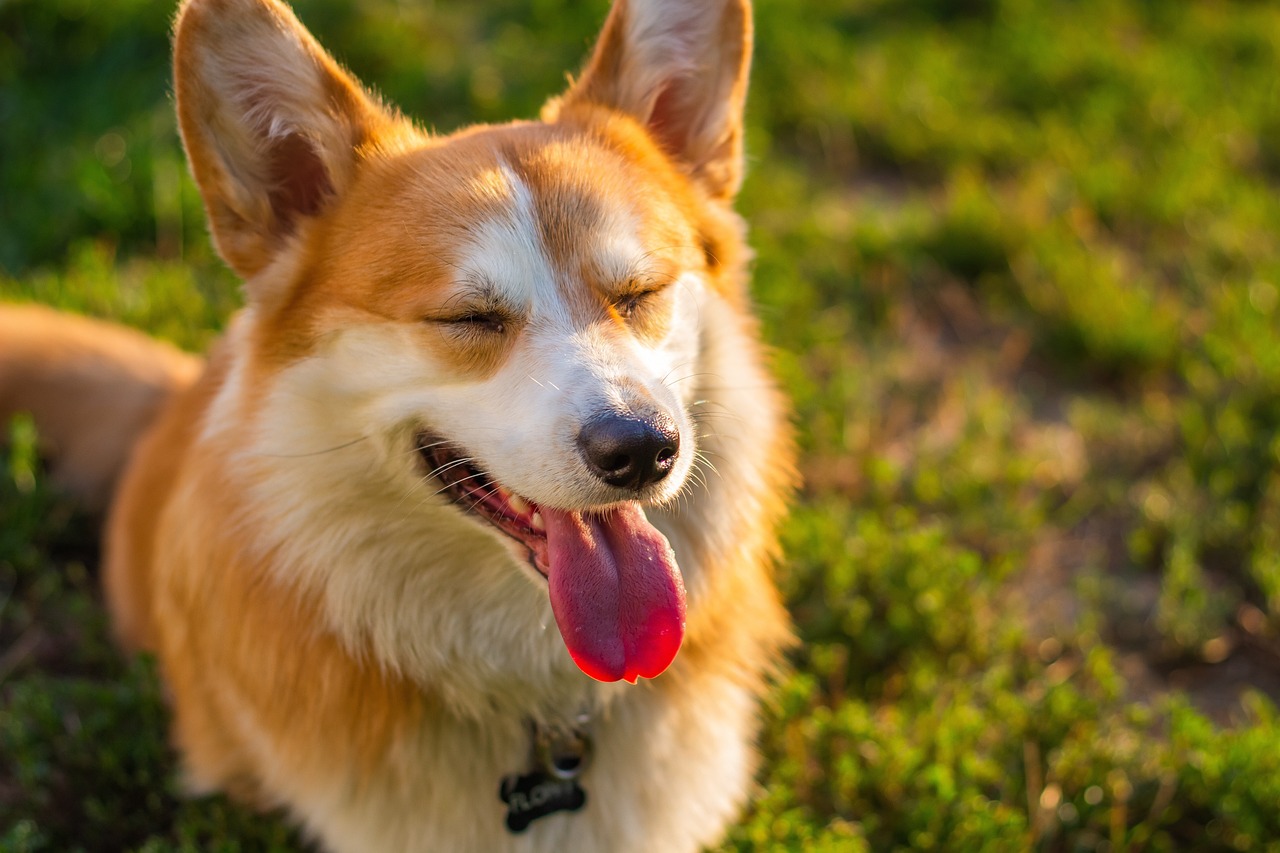
The Science of Dog Breeds
When we think about our furry friends, it's hard not to marvel at the incredible variety of dog breeds out there. Each breed comes with its own unique set of characteristics, and understanding these can be a game-changer for potential dog owners. So, what exactly shapes a dog's behavior? The answer lies in a fascinating blend of genetics and environment.
At the core of a dog's behavior is its genetic makeup. Just like humans, dogs inherit traits from their parents. These traits can include everything from physical appearance to personality quirks. For example, a Border Collie is known for its high intelligence and herding instincts, while a Bulldog is often more laid-back and affectionate. This genetic predisposition can significantly predict how a dog will behave in various situations.
To help illustrate this concept, consider the following table that outlines some common breeds and their associated behavioral traits:
| Breed | Common Traits | Typical Behavior |
|---|---|---|
| Border Collie | Intelligent, Energetic | Highly trainable, requires mental stimulation |
| Bulldog | Affectionate, Easygoing | Laid-back, enjoys lounging around |
| Golden Retriever | Friendly, Loyal | Great family dogs, love social interactions |
| Jack Russell Terrier | Active, Intelligent | Needs plenty of exercise, can be stubborn |
But it’s not just genetics that play a role in shaping a dog’s behavior. The environment in which a dog is raised also has a significant impact. Factors such as socialization, training, and the overall living conditions can either enhance or diminish the natural tendencies of a breed. For example, a well-socialized puppy is likely to grow into a well-adjusted adult dog, regardless of its breed. Conversely, a dog that is not exposed to various experiences may develop behavioral issues.
Moreover, the interaction between genetics and environment can be likened to a dance. Each breed has its own rhythm, but the steps they take can vary dramatically based on their surroundings. This is why responsible ownership is crucial—understanding a breed's innate traits allows owners to tailor their training and socialization efforts accordingly. After all, a dog that is aware of its place in the world, thanks to proper guidance and care, is more likely to thrive.
In summary, while breed characteristics provide a valuable framework for predicting a dog's behavior, the environment plays an equally important role. By combining genetic insights with responsible ownership practices, we can help our canine companions lead happy, fulfilling lives. So, whether you're considering adopting a new furry friend or just want to deepen your understanding of dogs, keep in mind that both genetics and environment are key players in the game of canine behavior.
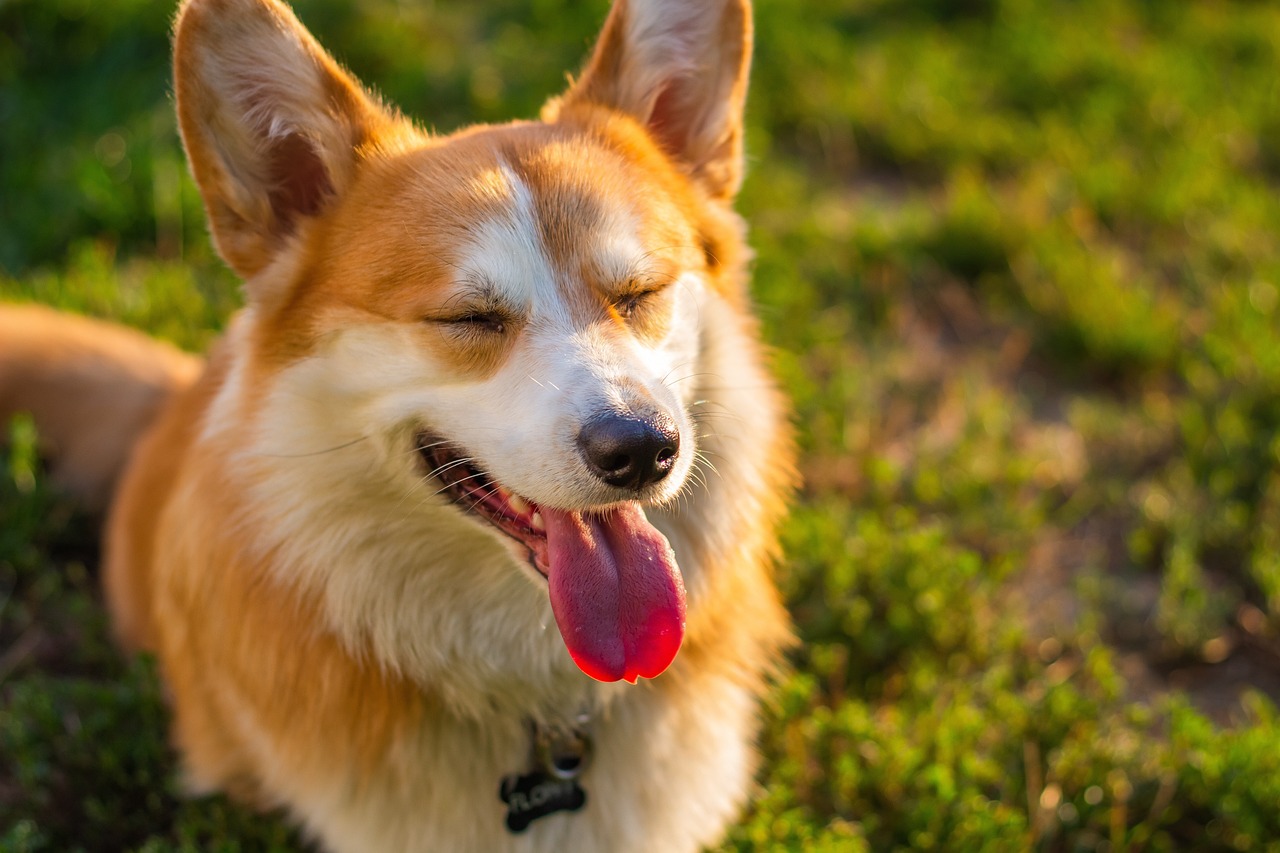
Common Behavioral Traits by Breed
When it comes to understanding our furry companions, it's crucial to recognize that each dog breed comes with its own set of behavioral traits that can significantly influence how they interact with the world. These traits are often a product of both genetics and environment, shaping not just how dogs behave, but also how they respond to training and socialization. For potential dog owners, knowing these traits can be the key to finding a perfect match for their lifestyle.
For instance, let's take a look at some popular breeds and their common behavioral tendencies. Each breed has unique characteristics that can either align perfectly with a person's lifestyle or create challenges. Understanding these traits can help you make informed decisions when choosing a furry friend.
| Breed | Common Traits | Ideal Environment |
|---|---|---|
| Labrador Retriever | Friendly, outgoing, and eager to please | Active families with plenty of outdoor space |
| German Shepherd | Intelligent, loyal, and protective | Experienced owners who can provide training and structure |
| Beagle | Curious, friendly, and sometimes stubborn | Families who can provide companionship and exercise |
| Bulldog | Gentle, affectionate, and laid-back | Apartment living with moderate exercise |
Now, let’s dive deeper into specific categories of breeds that exhibit distinct behavioral traits:
Working breeds, such as the Rottweiler and Siberian Husky, are known for their remarkable intelligence and high energy levels. These dogs thrive on having a job to do, whether it's pulling sleds, guarding property, or assisting in search and rescue operations. Their natural instincts drive them to be active, and they often require structured training and mental stimulation to keep their minds sharp. Without enough physical and mental engagement, they can become bored and develop behavioral issues.
Herding breeds, like the Border Collie and Australian Shepherd, are characterized by their intense drive to herd and control livestock. This instinct manifests in behaviors such as chasing and nipping, which can be fun to watch but also requires careful management. These breeds are typically energetic and need plenty of exercise, as well as mental challenges to prevent them from becoming restless. Engaging them in activities like agility training or obedience competitions can be a great way to channel their energy positively.
Sporting breeds, including Golden Retrievers and Spaniels, are often the life of the party! They are friendly, playful, and have a natural affinity for water and retrieving games. These dogs thrive on regular exercise and social interaction, making them excellent companions for active families. Regular outings to the park or participation in dog sports can help keep their spirits high and their behavior in check.
On the other end of the spectrum, we have toy breeds like the Chihuahua and Pomeranian. These pint-sized pups are often characterized by their affectionate and playful nature. Despite their small size, they can have big personalities! However, training these smaller dogs can present unique challenges. They may be more prone to small dog syndrome if not properly socialized and trained, leading to behaviors like excessive barking or possessiveness.
In conclusion, understanding the common behavioral traits associated with different dog breeds is essential for anyone considering bringing a dog into their home. By aligning a breed's characteristics with your lifestyle, you can foster a harmonious relationship that benefits both you and your new furry friend.
- What breed is best for a family with children?
Breeds like Labrador Retrievers and Golden Retrievers are known for their gentle and friendly nature, making them great companions for families. - How can I choose the right breed for my lifestyle?
Consider your activity level, living situation, and the time you can dedicate to training and socialization. Researching breeds that match your lifestyle is key. - Do all breeds require the same amount of exercise?
No, different breeds have varying energy levels. Working and sporting breeds generally need more exercise compared to toy or small breeds.
Working Breeds
When you think of , what comes to mind? These dogs are like the Swiss Army knives of the canine world—versatile, intelligent, and bursting with energy! They are not just pets; they are companions that thrive on purpose and activity. Breeds such as the German Shepherd, Rottweiler, and Siberian Husky are prime examples of dogs that excel in various tasks, from search and rescue to protection and service roles. Their innate intelligence and strong drives make them exceptional working partners, but they also require a unique approach to training and care.
One of the defining characteristics of working breeds is their high energy levels. Imagine a child who is always on the go, eager to explore and learn—this is what working breeds are like! They need plenty of physical and mental stimulation to keep them happy and healthy. Without adequate exercise, these dogs can become bored, leading to unwanted behaviors such as chewing, barking, or digging. So, if you're considering adding a working breed to your family, be prepared for a lifestyle that includes regular exercise, playtime, and training sessions.
Training working breeds can be incredibly rewarding, but it requires a firm yet gentle hand. These dogs respond best to positive reinforcement methods, which encourage good behavior through rewards like treats, praise, or play. Consistency is key here; just like a student needs regular classes to learn, these breeds thrive on structured training sessions that challenge their minds and bodies. Here are a few training tips to keep in mind:
- Start Early: Begin training and socialization as soon as you bring your puppy home. Early experiences can shape their future behavior.
- Keep It Fun: Use games and engaging activities to make training enjoyable, ensuring that your dog stays motivated.
- Be Patient: Every dog learns at their own pace. Patience and understanding will go a long way in building a strong bond.
Moreover, working breeds often have specific roles that they excel in due to their natural instincts. For instance, Belgian Malinois are frequently used in police work due to their keen sense of smell and agility, while Boxers are known for their protective nature, making them excellent family guardians. Understanding the specific traits and tendencies of each breed can help potential owners select the right dog that fits their lifestyle and needs.
In conclusion, owning a working breed can be a fulfilling experience, but it comes with responsibilities. These dogs require more than just love; they need dedication, training, and a lifestyle that accommodates their energetic nature. If you’re ready to embrace the challenge, a working breed can become a loyal friend and an invaluable partner in various activities.
Q: What are some examples of working breeds?
A: Common working breeds include the German Shepherd, Rottweiler, Siberian Husky, and Belgian Malinois. Each of these breeds has unique traits that make them suitable for specific tasks.
Q: How much exercise do working breeds need?
A: Working breeds typically require at least 60 minutes of vigorous exercise each day, which can include walks, runs, playtime, and training sessions.
Q: Can working breeds be good family pets?
A: Yes, many working breeds can be excellent family pets, provided they receive proper training, socialization, and exercise. It's important to match the breed's energy level and temperament with your family's lifestyle.
Q: What training methods work best for working breeds?
A: Positive reinforcement techniques are most effective for working breeds. Consistent training combined with rewards for good behavior helps them learn and thrive.
Herding Breeds
When we think of , images of dogs skillfully guiding flocks of sheep or cattle often come to mind. These breeds, including the Border Collie, Australian Shepherd, and German Shepherd, are not just adorable companions; they are equipped with unique instincts and behaviors that make them exceptional workers. Their inherent drive to herd stems from centuries of selective breeding, where traits such as intelligence, agility, and responsiveness were favored. This means that if you're considering bringing a herding breed into your home, you’re not just adopting a pet; you're inviting a bundle of energy and intelligence that thrives on challenge and activity.
Herding breeds are characterized by their high energy levels and need for mental stimulation. Unlike more laid-back breeds, these dogs require regular exercise and engaging activities to keep them happy and healthy. A simple walk around the block won’t cut it; they need a job to do! Whether it’s participating in agility training, herding trials, or even just playing fetch, these dogs flourish when they have a purpose. Without adequate physical and mental challenges, they can become bored and exhibit undesirable behaviors, such as digging, barking, or chewing. This can lead to frustration for both the dog and the owner.
It's fascinating to note that herding breeds often display specific behavioral traits that set them apart. For instance, their instinct to herd can manifest in various ways, including:
- Chasing: They might chase after moving objects or even people, which can be amusing but also requires careful management.
- Gathering: Many herding dogs will attempt to gather family members, demonstrating their natural herding instincts.
- Alertness: These breeds are typically very alert and can be highly protective of their family and territory.
Understanding these behaviors is crucial for prospective owners. It’s not just about finding a cute puppy; it’s about finding a match for your lifestyle. If you lead an active life and enjoy outdoor activities, a herding breed could be the perfect fit. However, if you're more of a couch potato, you might want to consider a breed that requires less exercise and stimulation. The key is to ensure that both you and your dog can thrive together, creating a harmonious living environment.
In conclusion, herding breeds are remarkable companions with a rich history of working alongside humans. Their intelligence and energy can bring joy and excitement to your life, but they also require a dedicated owner who is willing to provide the necessary training and engagement. So, if you're ready to embrace the challenge and reward of owning a herding breed, you’re in for an incredible journey full of love, loyalty, and adventure!
- What are some common herding breeds? Some popular herding breeds include the Border Collie, Australian Shepherd, and Corgis.
- Do herding breeds need a lot of exercise? Yes, herding breeds require regular physical and mental stimulation to stay happy and healthy.
- Can herding breeds live in apartments? While they can adapt, it's essential to provide them with plenty of exercise and mental challenges if living in a smaller space.
- How can I train a herding breed effectively? Positive reinforcement training methods work best for herding breeds, as they respond well to rewards and challenges.
Sporting Breeds
Sporting breeds are like the athletes of the dog world, bursting with energy and enthusiasm. These dogs are not just about looks; they are designed for action, often excelling in various physical activities. Breeds such as the Golden Retriever, Labrador Retriever, and English Springer Spaniel are prime examples of this category. They thrive on excitement and are always ready for a game of fetch or a swim in the lake. But what makes them so special? Let’s dive into their unique characteristics!
One of the defining traits of sporting breeds is their friendly nature. These dogs are typically social and outgoing, making them great companions for families and individuals alike. They enjoy being around people and other pets, which means they can seamlessly integrate into various social settings. However, this sociability also means they require regular interaction and stimulation to keep their spirits high. Imagine a child who loves to play; if they don’t get enough playtime, they might become restless or bored. The same goes for sporting breeds—they need their daily dose of fun!
When it comes to exercise, sporting breeds are at the top of the list. They need regular physical activity to maintain their health and happiness. A simple walk around the block won’t cut it; these dogs require vigorous exercise, which can include:
- Long runs
- Play sessions at the park
- Swimming
- Agility training
Without enough exercise, sporting breeds can become bored and may develop unwanted behaviors, such as chewing or excessive barking. Think of it like a pressure cooker: without a way to release steam, it might explode! Therefore, ensuring that these breeds have an outlet for their energy is crucial.
Training is another significant aspect of owning a sporting breed. Their intelligence and eagerness to please make them relatively easy to train, but it’s essential to use positive reinforcement techniques. Patience and consistency are key. These dogs respond well to rewards, whether it's treats, praise, or playtime. Just like a student in a classroom, they learn best when they feel encouraged and supported. Incorporating fun elements into training sessions can also keep their interest piqued, making the process enjoyable for both the dog and the owner.
In summary, sporting breeds are lively, friendly, and intelligent companions that thrive on activity and social interaction. Their playful demeanor and love for exercise make them ideal for active families or individuals who can provide the physical and mental stimulation they crave. If you’re considering adding a sporting breed to your family, be prepared for a lot of fun, laughter, and, of course, plenty of playtime!
Q: What are some popular sporting breeds?
A: Popular sporting breeds include Golden Retrievers, Labrador Retrievers, and English Springer Spaniels.
Q: How much exercise do sporting breeds need?
A: Sporting breeds typically require at least an hour of vigorous exercise each day, including activities like running, swimming, and playing fetch.
Q: Are sporting breeds easy to train?
A: Yes, sporting breeds are generally intelligent and eager to please, making them relatively easy to train with positive reinforcement methods.
Q: Can sporting breeds live in apartments?
A: While sporting breeds can adapt to apartment living, they require regular exercise and mental stimulation to prevent boredom and destructive behaviors.
Toy Breeds
Toy breeds are the pint-sized powerhouses of the canine world, often overflowing with affection and playfulness. These little furballs, such as Chihuahuas, Pomeranians, and Yorkshire Terriers, pack a big personality into their tiny frames. What’s fascinating about these breeds is that, despite their size, they often exhibit a wide range of behaviors that can be both endearing and challenging. Their small stature may lead some to underestimate their needs, but make no mistake: these dogs require just as much attention, training, and socialization as their larger counterparts.
One of the most charming aspects of toy breeds is their social nature. They thrive on human interaction and often form strong bonds with their owners. This can be both a blessing and a curse. On one hand, their affectionate demeanor makes them wonderful companions; on the other, they can develop separation anxiety if left alone for extended periods. Therefore, it's crucial for potential owners to consider their lifestyle and how much time they can dedicate to these little companions. After all, a lonely toy breed can become quite the handful!
Training toy breeds can present unique challenges. Due to their small size, it’s easy for owners to let minor behavioral issues slide, thinking, “Oh, they’re just a little dog!” However, this can lead to bigger problems down the line. For instance, behaviors like barking excessively or being overly possessive can become ingrained if not addressed early on. Therefore, consistent training and socialization are essential. Positive reinforcement techniques work wonders with these breeds, as they respond well to praise and treats. It's all about finding the right balance between setting boundaries and allowing them to express their playful nature.
Moreover, toy breeds often have a heightened sense of alertness, making them excellent watchdogs despite their size. They may not be able to physically deter an intruder, but their vocalizations can certainly alert you to any unusual activity. This trait can be both a blessing and a challenge, as their tendency to bark can sometimes become excessive, especially if they feel threatened or anxious. Understanding this characteristic can help owners manage their behavior effectively.
In terms of health considerations, toy breeds can be prone to certain issues such as dental problems, patellar luxation, and heart conditions. Regular veterinary check-ups and a proper diet are essential to keep these little guys healthy and happy. Additionally, their small size makes them susceptible to injuries, so providing a safe environment free from hazards is crucial.
In conclusion, while toy breeds may be small in size, they are large in personality and require a committed owner who understands their unique needs. With the right approach to training, socialization, and care, these little companions can bring immense joy and love into your life. Just remember, owning a toy breed is not just about having a cute pet; it’s about embracing the responsibility that comes with it!
- What are the most popular toy breeds? Some of the most popular toy breeds include the Chihuahua, Pomeranian, Yorkshire Terrier, and Maltese.
- Do toy breeds require a lot of exercise? Yes, despite their small size, toy breeds need regular exercise to stay healthy and happy. Short walks and playtime are essential.
- Are toy breeds good with children? Many toy breeds can be good with children, but it depends on the individual dog's temperament. Always supervise interactions between dogs and young kids.
- How can I train my toy breed effectively? Use positive reinforcement techniques, such as treats and praise, and be consistent with commands and boundaries.

Influence of Environment on Behavior
The environment in which a dog lives plays a crucial role in shaping its behavior. Just as humans are influenced by their surroundings, dogs absorb cues from their environments that can either enhance or hinder their natural instincts and tendencies. For instance, a dog raised in a bustling household with children and other pets may develop a sociable demeanor, while one kept in isolation might exhibit shyness or fearfulness. This interaction between a dog's breed traits and its environment is vital for understanding how to best nurture a canine companion.
Socialization is one of the most important factors in a dog's behavioral development. Early exposure to various people, animals, and settings helps puppies grow into well-adjusted adults. Imagine a puppy that only meets a few people during its formative months; it may grow up to be wary or anxious around strangers. Conversely, a puppy that experiences a variety of social situations is more likely to be confident and adaptable. This concept applies not only to puppies but also to adult dogs who may need additional socialization to overcome behavioral challenges.
Training also plays a significant role in a dog's behavior. Different breeds may respond better to specific training methods based on their inherent traits. For instance, a Border Collie, known for its intelligence and work ethic, may thrive with positive reinforcement techniques that challenge its mind and keep it engaged. On the other hand, a more stubborn breed, such as a Bulldog, might require a different approach that emphasizes patience and consistency. Understanding these nuances can help owners create a tailored training plan that aligns with their dog's natural inclinations.
Furthermore, the physical environment—such as the size of a living space and the availability of outdoor areas—can impact a dog's behavior significantly. Dogs that live in apartments may require more structured exercise routines to ensure they receive adequate physical and mental stimulation. Without sufficient outlets for their energy, these dogs can develop behavioral issues, such as excessive barking or destructive tendencies. In contrast, dogs with access to spacious yards can engage in free play, which often leads to happier and more balanced behavior.
To summarize, the influence of environment on a dog's behavior is multifaceted and critical for responsible pet ownership. By providing a nurturing and stimulating environment, socializing effectively, and employing appropriate training methods, owners can help their dogs thrive. This holistic approach not only benefits the dog but also fosters a harmonious relationship between pet and owner.
- How important is socialization for puppies? Socialization is vital for puppies as it helps them develop confidence and reduces the likelihood of behavioral issues later in life.
- Can training methods vary by breed? Yes, different breeds respond better to various training techniques, so it’s essential to tailor your approach to your dog's specific needs.
- What role does exercise play in a dog's behavior? Regular exercise is crucial for a dog's physical and mental health; insufficient activity can lead to behavioral problems.
- How can I create a stimulating environment for my dog? Providing toys, engaging in playtime, and allowing for social interactions with other dogs can create a stimulating environment.
Socialization Techniques
Socialization is one of the most crucial aspects of raising a well-adjusted dog. Just like humans, dogs thrive on experiences that help them understand the world around them. Imagine a puppy stepping out into the world for the first time; it’s a bit like a child entering a bustling playground. The sights, sounds, and smells can be overwhelming, but with the right guidance, this can become a positive adventure. Socialization techniques are designed to expose dogs to various environments, people, and other animals, ensuring they grow into confident and well-mannered companions.
One effective method of socialization is to start early. Puppies are particularly impressionable between the ages of 3 and 14 weeks, so this is the prime time to introduce them to different stimuli. During this period, they are more likely to accept new experiences without fear. Think of it as a critical window of opportunity where their brains are like sponges, soaking up everything around them. Positive experiences during this stage can set the foundation for a dog’s behavior throughout its life.
Another technique involves gradual exposure. If a dog is anxious around strangers, for instance, it’s essential to introduce them slowly to new people in a controlled environment. This could mean inviting friends over who are calm and gentle, allowing the dog to approach at its own pace. Use treats and praise to create a positive association with new experiences. It’s like teaching a child to ride a bike; you wouldn’t shove them onto the bike without a helmet and some guidance, right? You’d be there to support them, encouraging them as they learn to balance and steer.
Group classes can also be beneficial, providing structured environments where dogs can interact with others. These classes not only teach basic obedience but also allow dogs to encounter different breeds and personalities. It’s a bit like a doggy social club where they can learn the ropes of canine etiquette. However, it’s important to ensure that the classes are positive and that the trainers use humane methods. A good trainer will be able to read the dogs’ body language and ensure that interactions remain safe and enjoyable.
Additionally, exposing dogs to various environments is key. Take your furry friend on car rides, visits to parks, or even trips to pet-friendly stores. Each new experience is an opportunity for growth. Just remember to keep the experiences positive and not overwhelming. If your dog seems stressed, it’s better to retreat and try again later. Think of it as taking baby steps; you wouldn’t want to run a marathon without training first!
In conclusion, socialization techniques are vital in shaping a dog's behavior and ensuring that they become happy, well-adjusted members of society. By starting early, gradually exposing them to new experiences, enrolling them in group classes, and introducing them to various environments, you can help your dog navigate the world with confidence. Remember, the goal is to create positive associations, making each new experience a stepping stone toward a well-rounded canine companion.
- What is the best age to start socializing my puppy? The ideal age to start socializing your puppy is between 3 to 14 weeks, as they are most receptive to new experiences during this time.
- How can I tell if my dog is well-socialized? A well-socialized dog will generally be comfortable around different people, animals, and environments. They should display relaxed body language and curiosity rather than fear or aggression.
- What if my dog is fearful of new experiences? If your dog shows fear, take it slow. Gradual exposure and positive reinforcement can help. Consider consulting a professional trainer for additional guidance.
- Are group classes necessary for socialization? While not strictly necessary, group classes can be very beneficial for socialization as they provide a controlled environment for dogs to interact with others.
Training Approaches by Breed
When it comes to training our furry friends, understanding that not all dogs are created equal is crucial. Each breed comes with its own unique set of characteristics, which can significantly influence how they respond to various training methods. For instance, herding breeds like Border Collies and Australian Shepherds are renowned for their intelligence and eagerness to please, making them highly trainable with positive reinforcement techniques. On the other hand, toy breeds, such as Chihuahuas and Pomeranians, may require a different approach due to their smaller stature and sometimes stubborn nature. This means that what works for one breed might not be effective for another, highlighting the importance of tailoring training to suit individual needs.
To effectively train a dog, it's essential to consider their breed's natural instincts and behavioral tendencies. For example, working breeds like German Shepherds and Rottweilers thrive on structured training and tasks that challenge their intellect and physical abilities. These dogs often excel in obedience training and can be taught complex commands relatively quickly. Conversely, sporting breeds such as Golden Retrievers and Labrador Retrievers are typically friendly and eager to engage in activities, which makes them ideal candidates for training that incorporates play and social interaction. This not only keeps them motivated but also strengthens the bond between dog and owner.
Moreover, some breeds, particularly those with a strong prey drive, might require specialized training methods to manage their instincts effectively. For instance, hound breeds like Beagles may benefit from training that channels their natural scent-tracking abilities into positive behaviors rather than chasing after every squirrel they see. This could involve using scent games and rewards to reinforce desirable actions, thus transforming their instinctual behaviors into constructive activities.
In addition to breed-specific traits, the training environment plays a pivotal role in a dog's learning process. A calm and distraction-free space can enhance focus, while a chaotic environment may lead to frustration for both the dog and the trainer. Therefore, it’s essential to create a conducive atmosphere for training sessions, especially for breeds that are easily distracted.
Ultimately, the key to successful dog training lies in patience, consistency, and understanding. Recognizing and respecting the unique traits of each breed allows owners to implement the most effective training strategies. This not only leads to a well-behaved dog but also fosters a deeper connection between the pet and its owner. So, whether you’re working with a high-energy working breed or a laid-back toy breed, remember that the journey of training is as important as the destination.
- What is the best training method for my dog?
The best training method depends on your dog's breed, age, and personality. Positive reinforcement is generally effective for most breeds. - How long should training sessions last?
Training sessions should be short and engaging, typically lasting between 5 to 15 minutes, especially for puppies. - Can all breeds learn the same commands?
While most breeds can learn similar commands, some may take longer or require different approaches based on their temperament and instincts. - Is it too late to train an older dog?
It's never too late to train a dog! Older dogs can learn new behaviors and commands, though they may require more patience.

The Role of Genetics and Environment
When it comes to understanding a dog's behavior, the interplay between genetics and environment is crucial. Just like humans, dogs inherit certain traits from their parents that can significantly influence their personality and actions. For instance, a breed known for its intelligence may produce offspring that are quick learners, while a breed with a history of being protective might lead to dogs that are naturally wary of strangers. However, these genetic predispositions are only part of the story.
Imagine a dog that comes from a lineage of champion herders. While it may have the innate ability and instincts to gather sheep, if it grows up in a chaotic environment with little exposure to livestock, its behavior might not align with its genetic potential. This illustrates the importance of environmental factors—socialization, training, and daily experiences play a massive role in shaping how a dog behaves throughout its life.
To better understand this dynamic, consider the following aspects:
- Genetic Factors: These include breed-specific traits that can determine a dog's natural inclinations, such as energy levels, temperament, and intelligence.
- Environmental Influences: Factors such as early socialization, training methods, and the home environment can either enhance or diminish a dog's inherited traits.
- Interaction of Both: A well-bred dog raised in a nurturing environment is likely to exhibit positive behaviors, while a poorly bred dog in a stressful setting may develop behavioral issues.
Studies have shown that dogs with a solid genetic foundation often thrive better in various environments, but those same dogs can also experience behavioral challenges if not properly socialized. For example, a Labrador Retriever, known for its friendly disposition, might still develop anxiety if it is not exposed to different people and situations during its formative months. This highlights the need for responsible ownership, where potential dog owners must consider both the breed's characteristics and the environment they can provide.
In conclusion, understanding the role of genetics and environment is essential for any prospective dog owner. By acknowledging that both elements work hand-in-hand, you can make informed decisions about the breed that fits your lifestyle and how to raise a well-adjusted companion. As you embark on this journey, remember that the right combination of genetics and a nurturing environment can lead to a happy, healthy dog.
- Q: Can a dog's behavior change as it ages?
A: Yes, a dog's behavior can evolve due to changes in environment, health, and experiences. - Q: How important is socialization for puppies?
A: Socialization is critical during the first few months of a puppy's life to ensure they grow up to be well-adjusted adults. - Q: Can training methods vary by breed?
A: Absolutely! Different breeds may respond better to specific training techniques based on their unique traits.
Frequently Asked Questions
- How do different dog breeds influence behavior?
Dog breeds have unique genetic traits that can significantly impact their behavior. For instance, working breeds like Border Collies are often more energetic and intelligent, requiring more physical and mental stimulation compared to toy breeds like Chihuahuas, who may be more affectionate and less demanding in terms of exercise.
- What are some common behavioral traits associated with specific breeds?
Common traits can vary widely among breeds. For example, herding breeds are known for their instinctual behaviors to gather and control, while sporting breeds tend to be friendly and playful. Understanding these traits can help potential owners choose a dog that fits their lifestyle and activity level.
- How can environment affect a dog's behavior?
A dog's environment plays a crucial role in shaping its behavior. Factors like socialization, training, and daily routines can either enhance or mitigate breed-specific traits. For instance, a well-socialized dog is likely to be more adaptable and less prone to behavioral issues.
- What are effective socialization techniques for dogs?
Effective socialization techniques include exposing dogs to various environments, people, and other animals in a controlled manner. Gradually introducing new experiences helps dogs become well-rounded and reduces the likelihood of fear-based behaviors.
- Are there specific training approaches that work better for certain breeds?
Yes, different breeds often respond better to tailored training methods. For example, a high-energy breed may benefit from positive reinforcement techniques that incorporate play, while a more laid-back breed might respond well to gentle guidance and consistent routines.
- How do genetics and environment work together to shape a dog's behavior?
Genetics provide the foundation for a dog's potential behaviors, while the environment influences how those traits are expressed. A dog with a genetic predisposition for high energy may become a well-behaved companion if raised in an active environment with plenty of exercise and mental challenges.







